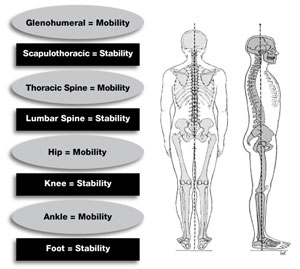This installment on how to improve stability and mobility
throughout the body focuses on exercises for the lower body, including
the hips, knees, ankles and feet. Remember from the first installment
that it is important to develop stability and mobility prior to adding
bigger movements, loading movements with external weight or increasing
intensity with the use of plyometrics.
You might be wondering if either stability or mobility is more important. Should stability be developed before mobility, or vice versa? To answer that, let’s take a look at the figure below.

You might be wondering if either stability or mobility is more important. Should stability be developed before mobility, or vice versa? To answer that, let’s take a look at the figure below.

Notice that stability and mobility alternates as we move up the body.
This figure indicates that the major joints complement each other in
that one should create more stability while the next should include more
mobility, and so on as we ascend the body.
If an area of the body that is meant to be more mobile, such as the
hips for example, is lacking in mobility, the areas either above or
below will be affected. So immobile hips may lead to the lumbar spine or
knee having to compensate, which can cause injuries in these more
stable joint areas.
The same is true for stability. If the knee lacks stability, the hip
and ankle may have to compensate to help protect the area, which can
lead to overcompensation, injury or imbalance.
Here are a few exercises that can help improve lower-body stability
and mobility. If your client is a beginning exerciser, use these moves
as his or her main workout, completing two to three sets of eight to 12
repetitions. For more advanced exercisers, use these moves as part of
their warm-ups and complete one to two sets of fewer than 10 reps.
Mobility (hip/ankle)
Kneeling Glute Circles
Begin in a table-top position and bring one knee up off the ground,
forward and then around in a circle. Practice drawing a circle both
clockwise and counter clockwise with both legs. Do not allow the pelvis
and trunk to shift; instead, move only from the hip joint.
Lunge With Elbow to Instep (Three Parts)
Glute Activation Lunges (Crossing Lunge)
Child’s Pose
Stability (foot/knee)
Inverted Flyers
Single-leg Glute Bridges
Lateral Lunges With Sliders
Put a slider under one foot and slowly slide that foot to the side,
hinging the hips back while tracking the standing knee over the foot.
Pull the sliding leg back up and repeat on the same side.
Mini-band Squat With Hip Abduction
Being in a squat position and place a mini-band around both legs just
above the knee. Hold a squat position and externally rotate the hip by
squeezing the glutes and moving the knee outward. Come back to the
center and repeat on the other side.
SOURCE : Jacqueline Crockford, MS, CSCS | ACE


No comments:
Post a Comment